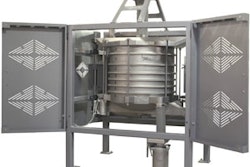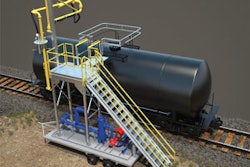 This is part two of a two-part piece. Part one can be found here.
This is part two of a two-part piece. Part one can be found here.
Actuators used in the food and beverage industry must be manufactured from appropriate materials and designed in a way that eliminates collection points where bacteria can flourish. Suitable actuators must also be capable of withstanding frequent washdowns with water, detergents, steam, caustic soda, citric acid or other types of sanitary cleaning solutions.
Design & Fabrication
The design of electric rod-style actuators for food and beverage applications needs to be free of crevices that may harbor bacteria, be sealed for washdown and have rounded surfaces with a smooth finish that sheds moisture. Motor housings, actuator bodies, corners and edges should be rounded to promote moisture runoff. Generally, a number 4 ground finish on stainless steel that is free of pits, cracks, folds or other imperfections is suitable for washdown applications. For welded junctions, electropolishing, glass beading and shot peening are not generally acceptable alternatives to a number 4 ground finish.
Permanent joints in the construction of an actuator, such as where the motor housing joins the screw barrel, may be either welded or gasketed, but any junction should be fully cleanable when assembled. Where two parts meet with a gasket, it is important to make sure the adjacent surfaces and the gasket are flush. If the gasket either protrudes or is recessed, it can form crevices that may collect moisture, food debris and bacteria. In cases where the actuator is assembled with O-rings instead of gaskets, make sure the O-ring completely fills the gap between the two mating parts. Actuators with grooves along the screw body to accept position switches would not be suitable for use in a food and beverage application.
Fasteners used on actuators intended for washdown environments also need to be able to shed water freely. Avoid socket head bolts, counter bored holes, slotted screws or knurled fasteners as they all have debris collection points. Hex head bolts or dome nuts are the preferred alternative. Make sure the actuator has no fasteners with exposed threads where debris can collect.
Whether an actuator is pneumatic, hydraulic or electric, it must be sealed properly so that dust, drips and washdown solutions do not contaminate the motor or internal mechanisms. Actuators with an IP65 or IP67 rating are protected against ingress of dust and high-pressure washdown under static conditions. For extreme high-pressure washdown environments, an IP69K rating offers the best protection.
While the IP69K rating is not synonymous with protection from chemical attack due to aggressive cleaning solutions, this rating does maintain a high level of ingress protection in high-pressure spray situations. It is therefore important to have an understanding of both the cleaning solutions intended to be used as well as the sealing elements employed in the actuator device to assure compatibility.
Actuator Maintenance
Maintenance of food processing or packaging equipment is vital for proper sanitation and maximum uptime. The harsh washdown environment is hard on equipment, and it is important to be constantly looking for any evidence of corrosion or less than optimum operation. Actuators, when specifically designed for washdown environments and properly sized for the application, can be very durable components. However, it is important to periodically inspect actuators for any signs of seal wear along the rod, loose components, pitting or corrosion Pitting or corrosion can create sites that collect moisture and also harbor debris or bacteria.
Conclusions
Actuators play an important role in processing and packaging machinery used in the food and beverage industry, where they must withstand frequent washdowns. The design of actuators used in these applications is critical to the health and safety of the products being produced. The materials from which they are fabricated must resist corrosion and harsh cleaning solutions, while not leaching toxic substances into the food products or packaging. Manufacturing engineers who select actuators that are designed for washdown and food and beverage applications will find that they are much easier to integrate into an application than actuators that need sanitary barriers or other types of shielding. With the emergence of catalog stainless steel electric rod-style actuators, engineers now have an economical way to incorporate electric actuators into food and beverage applications. By consulting with your actuator distributor or manufacturer early in the design phase of an application, engineers can ensure the most efficient, economical and safe food and beverage application.
For information on 3-A Sanitary Standards, please visit www.3-a.org.
For USDA guidelines on sanitary equipment design, please visit www.ams.usda.gov/AMSv1.0/getfile?dDocName=STELPRDC5048589.























